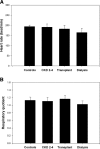Decreased maximal aerobic capacity in pediatric chronic kidney disease
- PMID: 18184856
- PMCID: PMC2391059
- DOI: 10.1681/ASN.2007070773
Decreased maximal aerobic capacity in pediatric chronic kidney disease
Abstract
Adult and pediatric patients with ESRD have impaired maximum oxygen consumption (VO(2) max), a reflection of the cardiopulmonary system's ability to meet increased metabolic demands. We sought to determine factors associated with decreased VO(2) max in pediatric patients with different stages of CKD. VO(2) max was measured using a standardized exercise testing protocol in patients with stage 2 to 4 chronic kidney disease (CKD) (n = 46), in renal transplant recipients (n = 22), in patients treated with maintenance hemodialysis (n = 12), and in age-matched healthy controls (n = 33). VO(2) max was similar between children with stage 2 CKD and controls, whereas lower VO(2) max was observed among children with stage 3 to 4 CKD, those treated with hemodialysis, and transplant recipients. In univariate analysis, VO(2) max was significantly associated with body mass index, resting heart rate, C-reactive protein, serum triglycerides, serum creatinine, and measures of diastolic function; no significant associations with left ventricular structure or systolic function were identified. In multivariate regression analysis, patient category versus control and the presence of diastolic dysfunction were independent predictors of lower VO(2) max. These results suggest that aerobic capacity is decreased in the early stages of CKD in children and that lower VO(2) max can be predicted by the presence of diastolic dysfunction, even if systolic function is normal.
Figures



Similar articles
-
Reduced Cardiovascular Reserve in Chronic Kidney Failure: A Matched Cohort Study.Am J Kidney Dis. 2015 Aug;66(2):274-84. doi: 10.1053/j.ajkd.2015.02.335. Epub 2015 Apr 18. Am J Kidney Dis. 2015. PMID: 25900597
-
Diastolic dysfunction of the cardiac allograft and maximal exercise capacity.J Heart Lung Transplant. 2009 May;28(5):434-9. doi: 10.1016/j.healun.2008.12.001. J Heart Lung Transplant. 2009. PMID: 19416770
-
Left ventricular diastolic filling pattern predicts cardiopulmonary determinants of functional capacity in patients with congestive heart failure.Am Heart J. 2000 Aug;140(2):338-44. doi: 10.1067/mhj.2000.108243. Am Heart J. 2000. PMID: 10925352
-
Exercise capacity improves with time in pediatric heart transplant recipients.J Heart Lung Transplant. 2009 Jun;28(6):585-90. doi: 10.1016/j.healun.2009.01.025. J Heart Lung Transplant. 2009. PMID: 19481019
-
Oxygen uptake kinetics during exercise in chronic heart failure: influence of peripheral vascular reserve.Clin Sci (Lond). 1999 Nov;97(5):569-77. Clin Sci (Lond). 1999. PMID: 10545307
Cited by
-
Cardiovascular disease in children with chronic kidney disease.J Am Soc Nephrol. 2012 Apr;23(4):578-85. doi: 10.1681/ASN.2011111115. Epub 2012 Mar 1. J Am Soc Nephrol. 2012. PMID: 22383696 Free PMC article. Review.
-
Longitudinal analysis of physical activity, fluid intake, and graft function among kidney transplant recipients.Transpl Int. 2009 Oct;22(10):990-8. doi: 10.1111/j.1432-2277.2009.00917.x. Epub 2009 Jul 10. Transpl Int. 2009. PMID: 19619168 Free PMC article.
-
Physical performance capacity after pediatric kidney transplant and clinical parameters associated with physical performance capacity.Pediatr Nephrol. 2023 May;38(5):1633-1642. doi: 10.1007/s00467-022-05758-0. Epub 2022 Oct 31. Pediatr Nephrol. 2023. PMID: 36315277 Free PMC article.
-
Cardiorespiratory fitness is a marker of cardiovascular health in renal transplanted children.Pediatr Nephrol. 2010 Nov;25(11):2343-50. doi: 10.1007/s00467-010-1596-9. Epub 2010 Jul 30. Pediatr Nephrol. 2010. PMID: 20676694
-
Six-minute walking test in children with ESRD: discrimination validity and construct validity.Pediatr Nephrol. 2009 Nov;24(11):2217-23. doi: 10.1007/s00467-009-1259-x. Epub 2009 Jul 25. Pediatr Nephrol. 2009. PMID: 19633871 Free PMC article.
References
-
- Booher MA, Smith BW: Physiological effects of exercise on the cardiopulmonary system. Clin Sports Med 22: 1–21, 2003 - PubMed
-
- Stephens P Jr, Paridon SM: Exercise testing in pediatrics. Pediatr Clin North Am 51: 1569–1587, 2004 - PubMed
-
- Painter P, Messer-Rehak D, Hanson P, Zimmerman SW, Glass NR: Exercise capacity in hemodialysis, capd, and renal transplant patients. Nephron 42: 47–51, 1986 - PubMed
-
- Krull F, Schulze-Neick I, Hatopp A, Offner G, Brodehl J: Exercise capacity and blood pressure response in children and adolescents after renal transplantation. Acta Paediatr 83: 1296–1302, 1994 - PubMed
-
- Van den Ham EC, Kooman JP, Schols AM, Nieman FH, Does JD, Franssen FM, Akkermans MA, Janssen PP, van Hooff JP: Similarities in skeletal muscle strength and exercise capacity between renal transplant and hemodialysis patients. Am J Transplant 5: 1957–1965, 2005 - PubMed
Publication types
MeSH terms
Grants and funding
LinkOut - more resources
Full Text Sources
Medical
Research Materials

